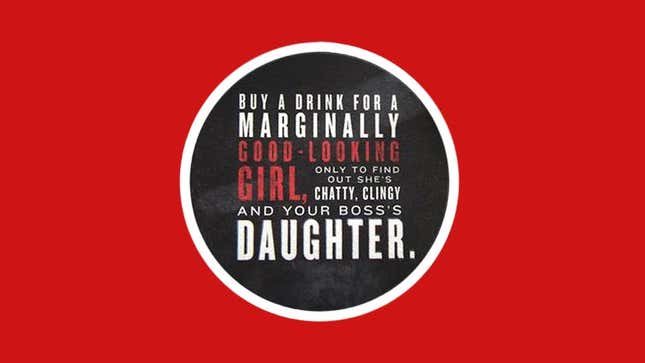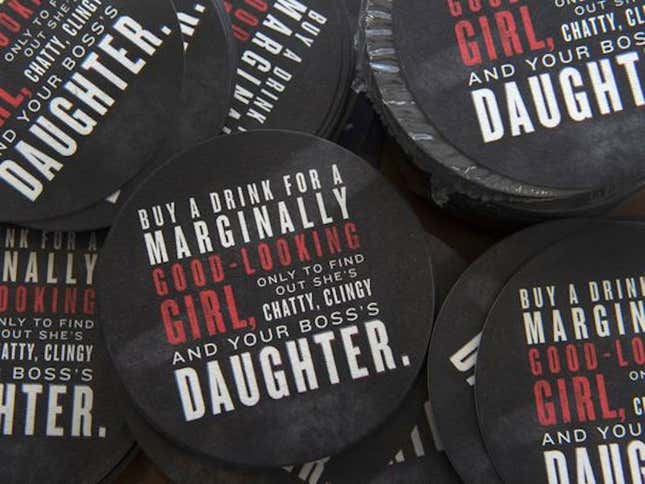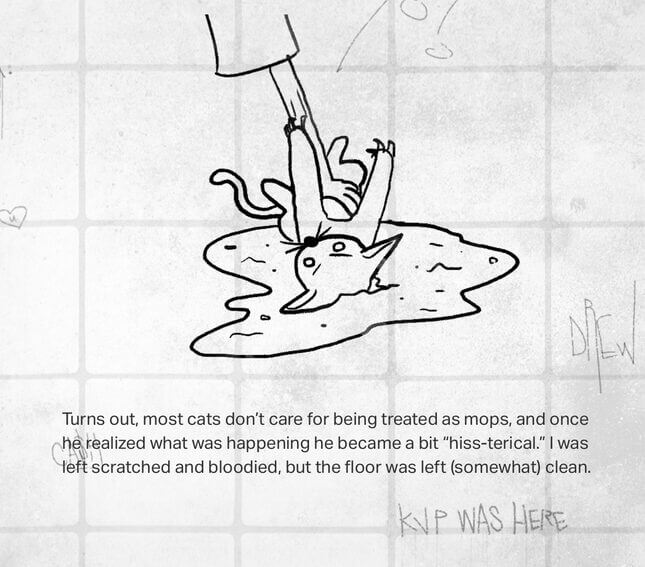Cancelled Anti-DUI Campaign: Drunk Driving as Scary as Banging an Uggo
Latest

Encouraging folks not to drink and drive is a good idea with many ways of implementation. You could make it harder to drink, you could make it harder to drive, you could make it easier to get home. Or, you could simply remind young men of the danger that they might fuck a girl who isn’t really that hot. That’s what Tennessee did in a recent—and even more recently cancelled—campaign to raise awareness.
Reporting at the Tennessean, Jordan Buie and Natalya Neysa Alund note that the Tennessee Governor’s Highway Safety Office took some heat for their messages aimed at young men to help them realize they’ve had too much to drink. They write:
The campaign boasts slogans that refer to girls looking “hotter” when guys are under the influence and finding out “a marginally good-looking girl” later is “chatty,” “clingy” or “your boss’s daughter” as signs that maybe a man has had too much to drink.
Here’s a photo of the coasters sent out as part of the campaign, which a server at Nashville bar/restaurant Charlie Bob’s found offensive:

Drunk driving: Just like fucking a 2, am I right?
Also in the bathroom at Charlie Bob’s was a flier that read: “After a few drinks the girls look hotter and the music sounds better. Just remember: If your judgment is impaired, so is your driving.”
The Tennessean got to the bottom-dwelling bottom of it:
The fliers and coasters seem to be part of a form of “social norms marketing” mentioned by the Governor’s Highway Safety Office in a 2015 Highway Safety Performance Plan. The plan said this type of marketing targets high-risk populations with messages about normal behaviors, as opposed to “commonly held beliefs about exaggerated substance abuse norms.”
Another part of the campaign mimics the graffiti on the inside a bathroom stall in one section of the highway safety office website, impaired.tntrafficsafety.org. In the section called “Legends of the Stall,” behaviors such as binge drinking, promiscuity and cleaning up vomit with a cat are among the activities of featured graffiti characters who, at the end of their nights, choose not to drive home drunk.
…In one stall story, the drawing of an inebriated young man proclaims that although he bet everyone at the bar $100 he was the best dancer, he didn’t drive home drunk or sleep with a “creepy older woman” who got “lucky” that night.
Those creepy older women will getcha every time, won’t they? They should be lucky we even let them out of the house, in a legal sense!
Following complaints from consumers, bar-goers and a state representative, the videos, posters, and other associated materials are no longer up at the Tennessee traffic safety site section on drinking and driving. The Washington Post reports that the Tennessee Governor’s Highway Safety Office issued a statement via director Kendell Poole, reiterating that no state dollars were used for the campaign, and also:
“It was never the intent of the GHSO to be insensitive or insulting to women.”
The coasters, posters and table tents associated with the federally funded campaign “will no longer be distributed and are being removed from bars across the state,” Poole said, adding that a companion Web site has been shut down.
That companion website is Booze It and Lose it, and it’s indeed dead. But, before it was pulled, Chris Butler made note of the campaign’s other dubious aspects in a post at Tennessee Watchdog:
In one of the campaign’s radio ads a man who’s had too much to drink tells a woman she’d “be cuter with the lights off.”
A series of videos on the website involve a drunk man clumsily hitting on women and commenting on their looks.
“Plastic surgery would do wonders for your jaw structure and definitely your nose,” the man says.
… In a story titled “I’m so sorry Mr. Mittens,” the campaign’s website tells a story about a drunk man who uses a cat to mop his vomit.
He preserved part of that last story:

These ads are ostensibly supposed to help young people identify when they’ve had too much to drink, so as (I assume) to know when to hand the keys over or call an Uber. But in an attempt to be funny, they mix a lot of messages instead of sending a clear one about why drinking and driving is bad, and why it’s so important to be aware of when you’ve had too much.
Why not use facts about drink limits, how long it takes to process one drink, or how to do any number of things to pace yourself and drink responsibly or decide when you’ve really had enough? It’s not like I don’t get what they were going for here. People do all sorts of stupid things when they are drunk. And advertising should certainly try to cater to its audience at their level, and it never hurts to be funny or relatable. But some of the best anti-drunk driving campaigns show real consequences of drinking and driving—jail time, murder, horrible, gruesome car accidents, tragic, heartfelt confessions of drunk drivers who killed people and have to live with the guilt forever. In tandem with this, municipalities can make it really really stupid easy to get home for free, without judgment, if they want to curtail drinking. Governments should not be in the business of punching at women’s looks and reinforcing nasty stereotypes about dudes on the prowl as a way to make the city safer for everyone.
Governor’s Highway Safety Office Director Kendell Poole stated that the “new initiative was designed to reach the young male demographic, who are statistically more likely to drive under the influence. Well-known adages, like dating the boss’s daughter, were used to grab their attention within the bar environment.”
But wait: What adage is that? I seriously don’t know it. Don’t fuck the boss’s daughter because she might be not that hot?
Worth noting: On their own, these messages aren’t even that clear. Presumably, you’re already at a bar, and you’re already drinking by the time you see them. If you’re seeing this flier in the bathroom, it’s highly likely you haven’t even hit the bathroom until it’s time to “break the seal,” which is easily a few drinks in. Already buzzing, this campaign asks that you notice and realize that these girls who now “look hotter” after a few brewskies weren’t so hot before, and what’s more, to doubt this new, softer criteria you’re employing. To not trust it.
I’m not calling myself an expert, but this is not really how drunk judgment works. “This guy sure wasn’t that hot before, but he sure is hot now” has never happened to me. Either he was never hot, or he was always hot enough. What changes is not someone’s perceived attractiveness, but what you feel like doing about it.
The fact that this campaign was pulled almost immediately is promising. It’s strange that this campaign would have made it to market, but luckily the market is quick to say that anti-DUI campaigns don’t need to amuse us, or insult us, or perpetuate cheap, easy, ideas about gender. They need to scare us a little or tell us a lot, so we’ll start caring about something substantive while we still have the intelligence to make good choices—which is usually well before we’ve had too much to drink.
Contact the author at [email protected].
Images by Tara Jacoby, the Tennessean, Tennessee Watchdog